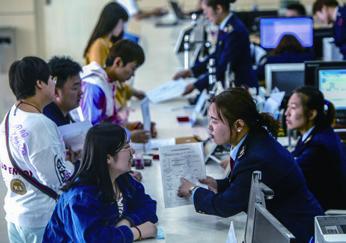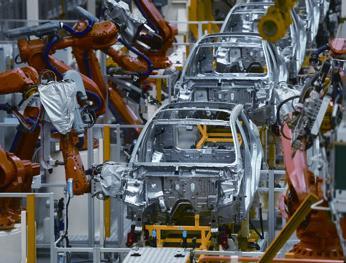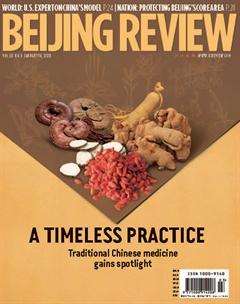A New Year Gift
By Li Xiaoyang
The Second China International Import Expo held in Shanghai in November 2019 offered diabetes patients a wide array of treatment products. They ranged from tiny insulin injection needles from Japan to blood glucose monitors using biosensors, an innovation by health and wellness company Sinocare, headquartered in Changsha, Hunan Province in central China.
Huang Guoan, chief financial officer of Sinocare, said supportive government policies for private fi rms, including tax cuts, had helped the company innovate.
“Value-added tax cuts saved around 7 million yuan ($1 million) for Sinocare in 2019, which allowed us to invest more in technological research and development,”Huang told Chinanews.com.
In 2019, Chinas business environment saw remarkable improvements, boosting the private sector. The years Fortune Global 500 list had 129 Chinese companies, of which 39 were private ones.

Since these companies have played a key role in driving innovation, creating jobs, improving peoples wellbeing and ex- panding opening up, the government will continue to provide more support and ensure fair competition for them, a guideline released by the Communist Party of China Central Committee and the State Council in December 2019 promised.
On January 6, the Peoples Bank of China (PBC), the central bank, cut the amount of cash that financial institutions are required to hold in reserve by 50 basis points to release an estimated 800 billion yuan ($115 billion) into the fi nancial sector to bolster the economy and reduce social fi nancing costs.
The measures will inject impetus into the market and boost the confidence of private enterprises, Liu Zhe, Vice President of WANB Institute, a Beijing-based economic think tank, told China Business Journal.
An impressive role
Private enterprises have made significant contributions to the Chinese economy. They have contributed around 50 percent of tax revenue, 60 percent of GDP, 70 percent of technological innovation, 80 percent of urban employment and 90 percent of new jobs and new fi rms, according to offi cial statistics.
A report on Chinas fourth economic census released by the National Bureau of Statistics (NBS) in December 2019 put the number of private small, micro and medium-sized companies at 15.27 million at the end of 2018, accounting for 84.4 percent of all business entities.
Data from the General Administration of Customs of China showed that the imports and exports of private firms totaled 12.12 trillion yuan ($1.7 trillion) in the fi rst 11 months of 2019, up 10.4 percent year on year and contributing 42.5 percent of the countrys overall foreign trade.
Private firms today have wider access to many areas that their state-owned counterparts used to dominate, such as the civil aviation and space industries. A 2019 report from FutureAerospace, a Chinese industry think tank, said the number of private space companies has surged in recent years, with 57 established in three years. In 2018, China had 141 registered commercial space companies, of which 90 percent were private.
To give full play to the role of private businesses, the government has reduced their burdens and developed a more favorable business environment with substantial tax and fee cuts, which include the reduction of the value-added tax and social security contribution rates in 2019.
Minister of Finance Liu Kun said in a report to a session of the Standing Committee of the National Peoples Congress, the countrys top legislature, last December that private businesses were the main beneficiaries of the tax cuts. In the fi rst 10 months last year, reductions for them amounted to more than 1.05 trillion yuan ($151 billion), 63.8 percent of total tax cuts.
During the first 11 months of 2019, profits and value-added industrial outputs of private companies surged 14.7 percent and 8.9 percent, respectively, the NBS said.
Further support
Amid global uncertainties and domestic downward economic pressure, the government has stepped up support for the private sector.
According to the guideline, private firms will be allowed to enter key sectors including oil and gas exploration, telecommunications, railway, power generation and fi nancial services. The government will also support qualified private companies to engage in crude oil import and export of refi ned oil products.
“The opening up of the sectors is expected to create a more level playing fi eld and add vitality to the industries,” Jiang Zhen, a research fellow at the National Academy of Economic Strategy at the Chinese Academy of Social Sciences, said.
As a report by brokerage company Huatai Securities suggests, the participation of private fi rms can improve the export of refi ned oil products, which will help address overcapacity at home.
Besides ensuring fair competition, the guideline also raised of further tax and fee cuts, improving the legal system and upgrading financial services, especially making financing more accessible and affordable.
According to a report on Chinas top 500 private enterprises released by the All-China Federation of Industry and Commerce in 2019, financing problems are still largely hampering the development of the non-state sector. Over half of the 500 companies felt funding pressures in 2018.
The PBC said after the latest reserve requirement ratio cut that the move will improve the lending capacities of small and medium-sized commercial banks, which are the main sources of loans to private fi rms. It is expected to bring more than 120 billion yuan ($17.2 billion) to these banks.
The interest rate of targeted mediumterm lending facilities—the price of the central banks lending to financial institutions—can also be lowered to make small and medium-sized banks loans much cheaper, Dong Ximiao, a researcher at the National Institution for Finance and Development, said.
While banks are making loans more affordable, many private fi rms still fi nd it hard and costly to obtain money mainly due to high collateral requirements and excessive intermediary charges, Wen Bin, chief researcher with China Minsheng Bank, told Beijing Review.
According to Chen Yongjie, former Deputy Secretary General of the China Center for International Economic Exchanges, Chinas private enterprises enjoy only around 40 percent of credit resources, since a high bad loan ratio results in unfavorable treatment when seeking bank loans. A report by the China Banking and Insurance Regulatory Commission in 2019 said the bad loan ratio of small and micro enterprises with credit lines of less than 10 million yuan ($1.4 million), mostly privately owned, was 5.9 percent, compared to 1.4 percent of large companies and 2.6 percent of medium-sized ones.

To address the problem, the guideline said credit loans will be increased, and intermediary and approval procedures will be slashed. For more sources of fi nancing, private companies are also encouraged to go public or issue bonds for direct fi nancing. Financial institutions that mainly lend to private enterprises will also be further improved. According to Liu Zhe, banks with customized services need to be developed to meet the differentiated demands of private fi rms.
“The measures can help private enterprises further reduce costs, improve effi ciency and expand fi nancing channels,”Wen said.
The way forward
Despite the signs of vitality, rising competition and weak performance have made it hard for many private enterprises to survive. As PBC Governor Yi Gang told the Lujiazui Forum in Shanghai in 2018, small and medium-sized enterprises in Japan can operate for 12 years on average, while their Chinese counterparts can survive for just three years.
The decline in global demand has also dampened market expectations of private enterprises in 2019, which led to weak investment growth. NBS data showed private fi xed assets investment increased 4.5 percent in the fi rst 11 months of 2019, 4.2 percentage points lower than that in the same period in 2018.
The guideline pointed out that private firms need to enhance technological innovation and industrial upgrading. As Shang Fulin, former Chairman of the China Banking Regulatory Commission, told a forum in December 2019, rising operation costs and a slowdown in imports and exports have added to the pressure on private companies. “Since problems such as business overexpansion and fi nancial irregularities have been exposed, fi rms need to improve their competitiveness against internal and external challenges,” he said.
Although some measures have been initiated, more targeted measures are required, according to Wu Changhai, Deputy Dean of the Institute of Capital and Finance of China University of Political Science and Law. He also suggested incorporating some initiatives in the guideline into laws to provide stronger support for the private sector.

